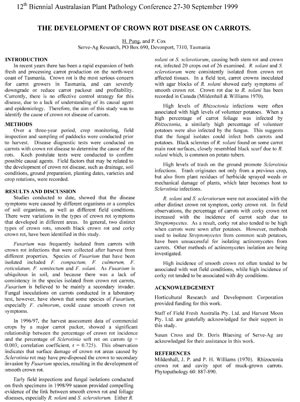|
|
Crown rot is a serious concern for carrot growers and can severely downgrade or reduce carrot packout and profitability. There is no effective control strategy for this disease, due to a lack of understanding of its causal agent and epidemiology. The aim of this study was to identify the cause of crown rot disease of carrots.
Studies showed that the disease symptoms were caused by different organisms or a complex of soil organisms, as well as different field conditions. Two distinct types of crown rots; smooth black crown rot and corky crown rot, were identified. High incidence of smooth crown rot were associated with wet field conditions. High incidence of corky rot twere associated with dry conditions. The 1996/97 harvest showed a significant relationship between the incidence of crown rots and the percentage of Sclerotinia soft rot on carrots. This observation indicates that surface damage of crown rot areas caused by Sclerotinia rot may have pre-disposed the crown to secondary invasion by Fusarium species, resulting in the development of smooth crown rot. Field observations indicate the percentage of carrots with corky rot increased with the incidence of carrot scab due to Streptomycetes. As a result, corky rot also tended to be high when carrots were sown after potatoes. Horticultural Research and Development Corporation provided funding for this work. Staff of Field Fresh Australia Pty. Ltd. and Harvest Moon Pty. Ltd. are gratefully acknowledged for their support in this study. Susan Cross and Dr. Doris Blaesing of Serve-Ag are acknowledged for their assistance in this work. |
||||
|

